Olivier Sigaud
ISIR
Controlling Intent Expressiveness in Robot Motion with Diffusion Models
Oct 14, 2025Abstract:Legibility of robot motion is critical in human-robot interaction, as it allows humans to quickly infer a robot's intended goal. Although traditional trajectory generation methods typically prioritize efficiency, they often fail to make the robot's intentions clear to humans. Meanwhile, existing approaches to legible motion usually produce only a single "most legible" trajectory, overlooking the need to modulate intent expressiveness in different contexts. In this work, we propose a novel motion generation framework that enables controllable legibility across the full spectrum, from highly legible to highly ambiguous motions. We introduce a modeling approach based on an Information Potential Field to assign continuous legibility scores to trajectories, and build upon it with a two-stage diffusion framework that first generates paths at specified legibility levels and then translates them into executable robot actions. Experiments in both 2D and 3D reaching tasks demonstrate that our approach produces diverse and controllable motions with varying degrees of legibility, while achieving performance comparable to SOTA. Code and project page: https://legibility-modulator.github.io.
I-FailSense: Towards General Robotic Failure Detection with Vision-Language Models
Sep 19, 2025Abstract:Language-conditioned robotic manipulation in open-world settings requires not only accurate task execution but also the ability to detect failures for robust deployment in real-world environments. Although recent advances in vision-language models (VLMs) have significantly improved the spatial reasoning and task-planning capabilities of robots, they remain limited in their ability to recognize their own failures. In particular, a critical yet underexplored challenge lies in detecting semantic misalignment errors, where the robot executes a task that is semantically meaningful but inconsistent with the given instruction. To address this, we propose a method for building datasets targeting Semantic Misalignment Failures detection, from existing language-conditioned manipulation datasets. We also present I-FailSense, an open-source VLM framework with grounded arbitration designed specifically for failure detection. Our approach relies on post-training a base VLM, followed by training lightweight classification heads, called FS blocks, attached to different internal layers of the VLM and whose predictions are aggregated using an ensembling mechanism. Experiments show that I-FailSense outperforms state-of-the-art VLMs, both comparable in size and larger, in detecting semantic misalignment errors. Notably, despite being trained only on semantic misalignment detection, I-FailSense generalizes to broader robotic failure categories and effectively transfers to other simulation environments and real-world with zero-shot or minimal post-training. The datasets and models are publicly released on HuggingFace (Webpage: https://clemgris.github.io/I-FailSense/).
HERAKLES: Hierarchical Skill Compilation for Open-ended LLM Agents
Aug 20, 2025Abstract:Open-ended AI agents need to be able to learn efficiently goals of increasing complexity, abstraction and heterogeneity over their lifetime. Beyond sampling efficiently their own goals, autotelic agents specifically need to be able to keep the growing complexity of goals under control, limiting the associated growth in sample and computational complexity. To adress this challenge, recent approaches have leveraged hierarchical reinforcement learning (HRL) and language, capitalizing on its compositional and combinatorial generalization capabilities to acquire temporally extended reusable behaviours. Existing approaches use expert defined spaces of subgoals over which they instantiate a hierarchy, and often assume pre-trained associated low-level policies. Such designs are inadequate in open-ended scenarios, where goal spaces naturally diversify across a broad spectrum of difficulties. We introduce HERAKLES, a framework that enables a two-level hierarchical autotelic agent to continuously compile mastered goals into the low-level policy, executed by a small, fast neural network, dynamically expanding the set of subgoals available to the high-level policy. We train a Large Language Model (LLM) to serve as the high-level controller, exploiting its strengths in goal decomposition and generalization to operate effectively over this evolving subgoal space. We evaluate HERAKLES in the open-ended Crafter environment and show that it scales effectively with goal complexity, improves sample efficiency through skill compilation, and enables the agent to adapt robustly to novel challenges over time.
Imagine Beyond! Distributionally Robust Auto-Encoding for State Space Coverage in Online Reinforcement Learning
May 23, 2025Abstract:Goal-Conditioned Reinforcement Learning (GCRL) enables agents to autonomously acquire diverse behaviors, but faces major challenges in visual environments due to high-dimensional, semantically sparse observations. In the online setting, where agents learn representations while exploring, the latent space evolves with the agent's policy, to capture newly discovered areas of the environment. However, without incentivization to maximize state coverage in the representation, classical approaches based on auto-encoders may converge to latent spaces that over-represent a restricted set of states frequently visited by the agent. This is exacerbated in an intrinsic motivation setting, where the agent uses the distribution encoded in the latent space to sample the goals it learns to master. To address this issue, we propose to progressively enforce distributional shifts towards a uniform distribution over the full state space, to ensure a full coverage of skills that can be learned in the environment. We introduce DRAG (Distributionally Robust Auto-Encoding for GCRL), a method that combines the $\beta$-VAE framework with Distributionally Robust Optimization. DRAG leverages an adversarial neural weighter of training states of the VAE, to account for the mismatch between the current data distribution and unseen parts of the environment. This allows the agent to construct semantically meaningful latent spaces beyond its immediate experience. Our approach improves state space coverage and downstream control performance on hard exploration environments such as mazes and robotic control involving walls to bypass, without pre-training nor prior environment knowledge.
A tale of two goals: leveraging sequentiality in multi-goal scenarios
Mar 27, 2025Abstract:Several hierarchical reinforcement learning methods leverage planning to create a graph or sequences of intermediate goals, guiding a lower-level goal-conditioned (GC) policy to reach some final goals. The low-level policy is typically conditioned on the current goal, with the aim of reaching it as quickly as possible. However, this approach can fail when an intermediate goal can be reached in multiple ways, some of which may make it impossible to continue toward subsequent goals. To address this issue, we introduce two instances of Markov Decision Process (MDP) where the optimization objective favors policies that not only reach the current goal but also subsequent ones. In the first, the agent is conditioned on both the current and final goals, while in the second, it is conditioned on the next two goals in the sequence. We conduct a series of experiments on navigation and pole-balancing tasks in which sequences of intermediate goals are given. By evaluating policies trained with TD3+HER on both the standard GC-MDP and our proposed MDPs, we show that, in most cases, conditioning on the next two goals improves stability and sample efficiency over other approaches.
VIPER: Visual Perception and Explainable Reasoning for Sequential Decision-Making
Mar 19, 2025Abstract:While Large Language Models (LLMs) excel at reasoning on text and Vision-Language Models (VLMs) are highly effective for visual perception, applying those models for visual instruction-based planning remains a widely open problem. In this paper, we introduce VIPER, a novel framework for multimodal instruction-based planning that integrates VLM-based perception with LLM-based reasoning. Our approach uses a modular pipeline where a frozen VLM generates textual descriptions of image observations, which are then processed by an LLM policy to predict actions based on the task goal. We fine-tune the reasoning module using behavioral cloning and reinforcement learning, improving our agent's decision-making capabilities. Experiments on the ALFWorld benchmark show that VIPER significantly outperforms state-of-the-art visual instruction-based planners while narrowing the gap with purely text-based oracles. By leveraging text as an intermediate representation, VIPER also enhances explainability, paving the way for a fine-grained analysis of perception and reasoning components.
MAGELLAN: Metacognitive predictions of learning progress guide autotelic LLM agents in large goal spaces
Feb 12, 2025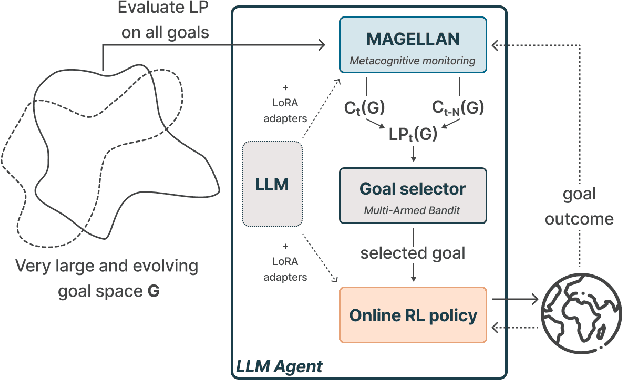
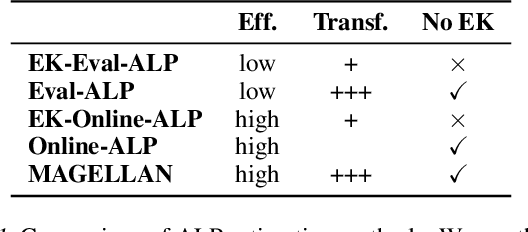
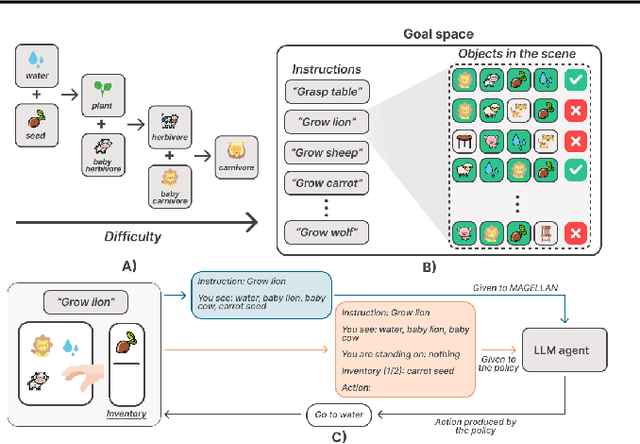
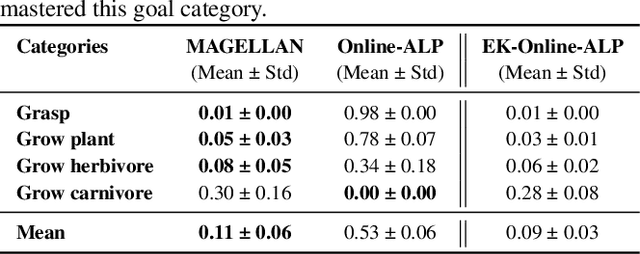
Abstract:Open-ended learning agents must efficiently prioritize goals in vast possibility spaces, focusing on those that maximize learning progress (LP). When such autotelic exploration is achieved by LLM agents trained with online RL in high-dimensional and evolving goal spaces, a key challenge for LP prediction is modeling one's own competence, a form of metacognitive monitoring. Traditional approaches either require extensive sampling or rely on brittle expert-defined goal groupings. We introduce MAGELLAN, a metacognitive framework that lets LLM agents learn to predict their competence and LP online. By capturing semantic relationships between goals, MAGELLAN enables sample-efficient LP estimation and dynamic adaptation to evolving goal spaces through generalization. In an interactive learning environment, we show that MAGELLAN improves LP prediction efficiency and goal prioritization, being the only method allowing the agent to fully master a large and evolving goal space. These results demonstrate how augmenting LLM agents with a metacognitive ability for LP predictions can effectively scale curriculum learning to open-ended goal spaces.
Reinforcement Learning for Aligning Large Language Models Agents with Interactive Environments: Quantifying and Mitigating Prompt Overfitting
Oct 29, 2024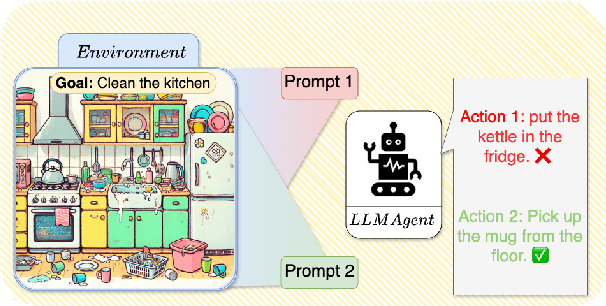

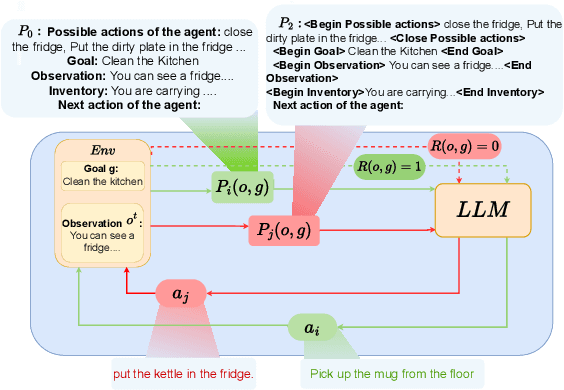

Abstract:Reinforcement learning (RL) is a promising approach for aligning large language models (LLMs) knowledge with sequential decision-making tasks. However, few studies have thoroughly investigated the impact on LLM agents capabilities of fine-tuning them with RL in a specific environment. In this paper, we propose a novel framework to analyze the sensitivity of LLMs to prompt formulations following RL training in a textual environment. Our findings reveal that the performance of LLMs degrades when faced with prompt formulations different from those used during the RL training phase. Besides, we analyze the source of this sensitivity by examining the model's internal representations and salient tokens. Finally, we propose to use a contrastive loss to mitigate this sensitivity and improve the robustness and generalization capabilities of LLMs.
SAC-GLAM: Improving Online RL for LLM agents with Soft Actor-Critic and Hindsight Relabeling
Oct 16, 2024



Abstract:The past years have seen Large Language Models (LLMs) strive not only as generative models but also as agents solving textual sequential decision-making tasks. When facing complex environments where their zero-shot abilities are insufficient, recent work showed online Reinforcement Learning (RL) could be used for the LLM agent to discover and learn efficient strategies interactively. However, most prior work sticks to on-policy algorithms, which greatly reduces the scope of methods such agents could use for both exploration and exploitation, such as experience replay and hindsight relabeling. Yet, such methods may be key for LLM learning agents, and in particular when designing autonomous intrinsically motivated agents sampling and pursuing their own goals (i.e. autotelic agents). This paper presents and studies an adaptation of Soft Actor-Critic and hindsight relabeling to LLM agents. Our method not only paves the path towards autotelic LLM agents that learn online but can also outperform on-policy methods in more classic multi-goal RL environments.
Bridging Environments and Language with Rendering Functions and Vision-Language Models
Sep 24, 2024



Abstract:Vision-language models (VLMs) have tremendous potential for grounding language, and thus enabling language-conditioned agents (LCAs) to perform diverse tasks specified with text. This has motivated the study of LCAs based on reinforcement learning (RL) with rewards given by rendering images of an environment and evaluating those images with VLMs. If single-task RL is employed, such approaches are limited by the cost and time required to train a policy for each new task. Multi-task RL (MTRL) is a natural alternative, but requires a carefully designed corpus of training tasks and does not always generalize reliably to new tasks. Therefore, this paper introduces a novel decomposition of the problem of building an LCA: first find an environment configuration that has a high VLM score for text describing a task; then use a (pretrained) goal-conditioned policy to reach that configuration. We also explore several enhancements to the speed and quality of VLM-based LCAs, notably, the use of distilled models, and the evaluation of configurations from multiple viewpoints to resolve the ambiguities inherent in a single 2D view. We demonstrate our approach on the Humanoid environment, showing that it results in LCAs that outperform MTRL baselines in zero-shot generalization, without requiring any textual task descriptions or other forms of environment-specific annotation during training. Videos and an interactive demo can be found at https://europe.naverlabs.com/text2control
 Add to Chrome
Add to Chrome Add to Firefox
Add to Firefox Add to Edge
Add to Edge